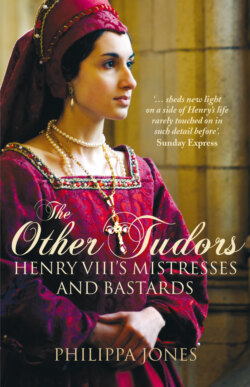Читать книгу Other Tudors: Henry VIII's Mistresses & Bastards - Philippa Jones - Страница 8
На сайте Литреса книга снята с продажи.
THE BOOK
ОглавлениеThis study examines all of the aforementioned women, as well as Henry’s illegitimate children. Here you will find all the ladies who captured the heart of the King. Of the ‘Great Loves’, he was tiring of Catherine when he took up with Bessie Blount. Bessie had ceased to be his love when he adored Mary Boleyn. After Mary, he spent two years looking before he settled on her sister, Anne. Anne’s loss of favour, opened the door for Jane Seymour; after Jane, Anne of Cleves came along. Anne vanished and Anne Bassett, Elizabeth Brooke and Elizabeth Cobham tussled for the position, only to be superseded by Catherine Howard. When Catherine could not hold Henry’s affections, it was time for Catherine Parr, and finally Katherine d’Eresby, his last passion.
Of the ‘Lighter Loves’, Elizabeth Denton, Anne Hastings, Etionette de la Baume and Jane Popincourt belong to Henry’s green youth, when he was trying his manhood, in love with life itself. Jane Stukeley, Mary Perrot, Joanna Dingley and Margaret Shelton are the result of Anne Boleyn keeping the King waiting and then, in his view, betraying him when it counted most; Henry, after all, was only human. These ladies gave him unconditional love and a hidden family of healthy, handsome, lively children, a source of secret pride.
Henry VIII’s illegitimate children all played significant roles in the history of the period. His sons, Henry Carey (see plate 13), Thomas Stukeley and John Perrot and their half-sister Etheldreda Malte, all shared an ability to get away with almost anything. Henry Carey, nephew to Anne Boleyn and a Protestant, survived the reign of his half-sister, Mary I; and despite a rough manner, became one of Elizabeth I’s most valued officers. Thomas Stukeley survived charges of piracy, spying and treason, and came away with nothing worse then a few weeks in prison. John Perrot, even when found guilty of defaming Elizabeth I, died of natural causes and not on the block.
As Henry VIII’s bastard daughter, Etheldreda Malte grew up in the household of the country’s most wealthy tailor. This glittering Tudor had the distinct auburn colouring and the sparkling wit. She married a ne’er-do-well, John Harrington, who faced death on several occasions under treason charges, but who survived to become rich and happy under Elizabeth I. Etheldreda protected her feckless husband and bore him a child, before dying quietly in their house near Bath. In 1554, she was one of the ladies who accompanied the future Elizabeth I, to the Tower where she was held by order of her sister Mary I; as their half-sister, both knew they could trust her loyalty and love (her mother’s relationship with Mary I and Etheldreda’s with Elizabeth I are explained in Chapter 9).
The lives of Etheldreda Malte, Henry Fitzroy, Henry Carey, John Perrot and Thomas Stukeley overlap and intertwine with each other and with those of their brother, cousin and sisters: Edward VI, Lady Jane Grey, Mary I and Elizabeth I. They burst like stars on to the scene, flame gloriously and are extinguished with a spark and then a whisper. Etheldreda had a daughter and Thomas Stukeley had at least one son, but their lines are lost. The family of Henry Carey flourished as did that of John Perrot – today one of the modern Perrots, of the bloodline of Henry VIII, is a dentist in Essex.
